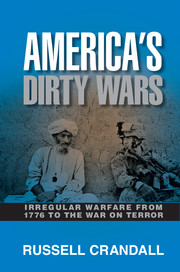Book contents
- Frontmatter
- Dedication
- Contents
- List of Figures
- Acknowledgments
- 1 Introduction
- 2 Irregular Warfare 101
- Part One The American Revolution to Chasing Sandino, 1776–1930s
- 3 The American Revolution
- 4 Confederates and Indians
- 5 Intermezzo
- 6 America, Aguinaldo, and the Philippines, 1898
- 7 Chasing Villa, 1916
- 8 A Cold Winter in Siberia
- 9 The Banana Wars, 1898–1930s
- 10 Intermezzo
- 11 Chasing Sandino, 1927–1932
- Part Two The Cold War, 1940s–1989
- Part Three Latin America and the Cold War, 1950s–1980s
- Part Four Post–Cold War, 1990s–2000s
- Notes
- Bibliography
- Index
8 - A Cold Winter in Siberia
Published online by Cambridge University Press: 05 July 2014
- Frontmatter
- Dedication
- Contents
- List of Figures
- Acknowledgments
- 1 Introduction
- 2 Irregular Warfare 101
- Part One The American Revolution to Chasing Sandino, 1776–1930s
- 3 The American Revolution
- 4 Confederates and Indians
- 5 Intermezzo
- 6 America, Aguinaldo, and the Philippines, 1898
- 7 Chasing Villa, 1916
- 8 A Cold Winter in Siberia
- 9 The Banana Wars, 1898–1930s
- 10 Intermezzo
- 11 Chasing Sandino, 1927–1932
- Part Two The Cold War, 1940s–1989
- Part Three Latin America and the Cold War, 1950s–1980s
- Part Four Post–Cold War, 1990s–2000s
- Notes
- Bibliography
- Index
Summary
We have no heart for the fight.
– Message written anonymously and shared among American troops awaiting their withdrawal, Siberia, 1920If nothing else, the Russian intervention is one of the classic examples of where war starts: in war rooms all over the world; warm, well-appointed rooms where men can play politics and dwell on the certainty of results rather than the magnitude of catastrophe.
– Richard GoldhurstAfter a bittersweet experience in the imperial pacification campaign in the Philippines after 1898, as well as the more recent mission to apprehend Pancho Villa in 1916, American troops found themselves involved in the epic conflagration of World War I. The United States’ belated military entrance into this war, in April 1917 with the declaration of war on Germany, proved decisive in the outcome of the conflict, helping to ensure the victory of America’s key allies, Britain and France.
While the collective memory of participation in this great conflict has naturally declined over time, Americans continue to evoke what they perceive as a generally noble involvement and a war fought largely in muddy trenches in France; yet, as World War I began its denouement, American soldiers deployed in Russia were only just embarking on a remarkable but forgotten dirty war that received scant attention compared to the American campaign in France.
- Type
- Chapter
- Information
- America's Dirty WarsIrregular Warfare from 1776 to the War on Terror, pp. 100 - 108Publisher: Cambridge University PressPrint publication year: 2014



